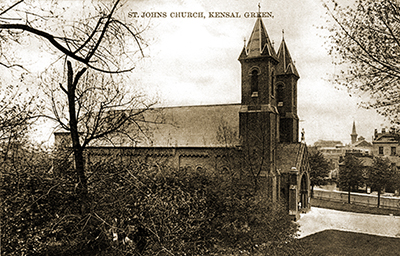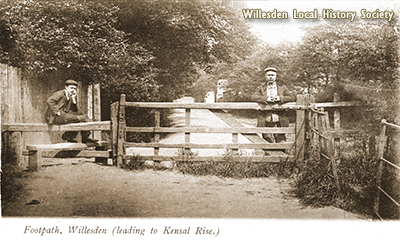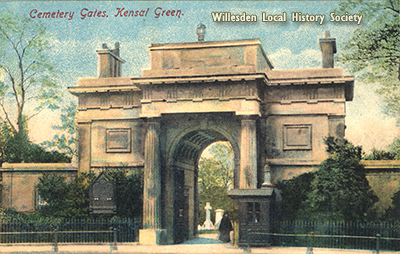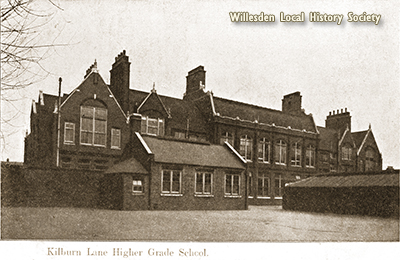
Kensal Green

The History of Kensal Green
The “Village Green” of Kensal Green was a strip of common land alongside the Harrow Road, running west from Kilburn Lane, up to where Wakeman Road begins today. The small settlement around the green was surrounded by farm land and market gardens, providing meat, milk, vegetables and fruit for the City of London, a few hours walk away. Hay for the horses of London was also an important crop. The name “Kensal” had its origins in “Kingisholt”, the 12th Century name of the area of land immediately to the east of Kilburn Lane.
The beginning of the 19th century brought industry and job opportunities to Kensal Green.
1801 – The Paddington Arm of the Grand Junction Canal was built across farmland just south of the Harrow Road.
1815-1823 – Acts of Parliament, The Enclosure Awards, meant that common land was able to be parcelled up and sold off for building.
1833 – All Souls’ Cemetery was built between the Harrow Road and the Canal, south of Kensal Green.
1837 – Robert Stephenson’s London –Birmingham Railway, (London North Western Railway,) now Bakerloo, Euston and main lines, was built across Kensal Green, passing under Harrow Road in a tunnel. Some farms at the east end of the area were cut off from their fields by the railtracks. About the same time, The Great Western Railway was being built south of the Canal by I.K.Brunel.
1840 – Kensal New Town was planned and laid out on 30 acres of Kingisholt, between the Canal and the G.W.R.
1844 – St John’s Church was built beside Kilburn Lane, to serve the New Town.
1845 – The Western Gas Works opened at Ladbroke Grove, south of the Canal.
1851 – Portobello Wharf opened at Kensal New Town.
1860 – The Hampstead Junction Railway, (now Overground , Richmond to Stratford,) crossed Kensal Green to the north of the LNWR, on its way to Willesden Junction.
This avalanche of events changed the little village of Kensal Green for ever, as people quickly moved into the area for work.
Noteable landmarks of the area are –
The Church of St.John the Evangelist, Kensal Green. Opened in 1844, on land donated by All Souls’ College, Oxford, to be the Parish Church serving Kensal New Town, south of the Canal.
The Plough Inn, Ladbroke Grove. The site of this ancient Inn was on the corner of what is now Ladbroke Grove, across the road from the Church. Another Plough Inn is not far away, in Kilburn Lane. The Ladbroke Plough is believed to have been patronised by the 18th Century artist, George Morland, who lived in Kensal Green, and painted rural scenes in Willesden and Kilburn. The Ladbroke Plough was rebuilt during the 19th Century, and demolished in 1997, replaced by flats and a salon.
The Harrow Road is an ancient way between Paddington and Harrow, important enough to be Turnpiked in the 19th Century. Tolls were collected at turnpike gates across the road, the money being used for road repairs.
Kensal Green Cemetery, (All Souls’ Cemetery,) lies between the Harrow Road and the Grand Junction Canal. It was opened in 1833, one of seven “Country Park” cemeteries built around London to relieve the pressure on the city churches’ overflowing burial grounds. The entrance gate, and the Chapels inside the cemetery are Neo-Classical in design, chosen in preference to the prizewinning Gothic design of H.E.Kendall ,Senior (father of the Architect of St John’s.)
The Case is Altered was a pub built at the west corner of Wellington Road, in about 1840, enlarged in 1900, then destroyed by a bomb in World War 2. William IVth is another early 19th Century pub, built on the edge of the Green, enlarged in 1893, rebuilt in 1927, and still trading. The land behind the pub was leased for housebuilding in 1888, giving us Pember Road, Rainham Road, and the rest of the area known locally as the Kensal Triangle. Further up Harrow Road there area some beautiful terraces of cottages, some of the oldest dwellings in Brent.
Holland and Holland, Gun Factory. The large building at the corner of Wakeman Road opened in 1880 and still makes luxury sporting shot guns and rifles.
Kensal Green Station. (Bakerloo and Euston Trains.) Originally built here at the corner of College Road in 1916, this was the last railway station to open in Willesden. It was rebuilt in 1980.
St. Martin’s Church (Dean Vaughan Memorial Church.) was built in 1900 to cater for the growing congregations of several mission churches in Kensal Green.
The Masons’ Arms. Built 1870, next along the Harrow Road, this handsome Victorian Pub was named for the Monumental Masons of Kensal Green. In the yard beside the Pub is a rare cast iron Horse-trough, safely enclosed behind a fence.
Kensal Green West Gate and entrance to St.Mary’s R.C. Cemetery. St. Mary’s Cemetery opened in 1860, on the land adjacent to Kensal Green Cemetery. At this point, the boroughs of Hammersmith and Kensington have their boundary, with Willesden.
The site of Tavistock Villa, built in 1835, one of three large houses from the same date along this part of the Harrow Road. Tavistock Villa would have been at 703 Harrow Road, opposite Felixtowe Road, but was demolished in 2002 and replaced by flats.
Kensal Lodge and Kensal Manor were a few yards further west on the same side as Tavistock Villa. Kensal Lodge was occupied by the Victorian novelist Harrison Ainsworth, from 1835 to 1841. He wrote some of his most famous works here, notably “Jack Sheppard,” “The Tower of London” and “Old St. Pauls.” Ainsworth moved into the more spacious Kensal Manor, next door, in 1841, and during his years there, acted as Churchwarden for St. John’s, Kensal Green. Kensal Manor was where Ainsworth famously entertained many of the literary Establishment of the day, including Charles Dickens and William Makepeace Thackeray. Ainsworth died in 1882, and was buried in Kensal Green Cemetery.
Wrottesley Road, past the parade of shops on the right, marks the end of Kensal Green, and is the site of a lost Railway station, “Harlesden and Kensal Green”, on the Hampstead Junction Railway, (Overground, Richmond to Stratford), which crosses under the road here. This station closed in 1890, and was moved to Chamberlayne Road, where it still is today, (now called Kensal Rise Station.) Wrottesley Road joins All Souls Avenue, to connect with the north end of Chamberlayne Road, and eventually, with Willesden Green.
Margaret Pratt, 2021
This is based on the online talk by Margaret Pratt and Harry Brown given to the WLHS in January 2021. The recording of the talk is available in the Archive section of the website, and detailed information is included in Journal 53, also available to members and in the Archive section of the website.



